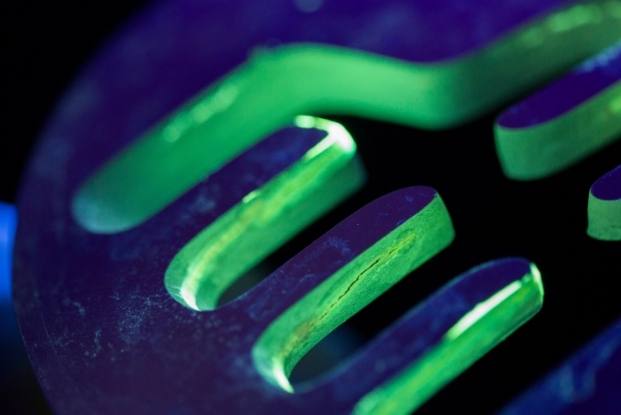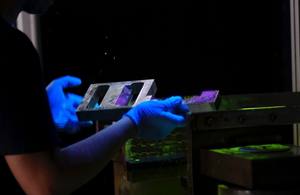MAGNETIC PARTICLE INSPECTION (MT)
TEC Eurolab
Non-destructive testing by magnetic particle inspection (MT)
Test surface and sub-surface discontinuities in ferromagnetic components
TEC Eurolab has numerous devices for performing magnetic particle testing, both on site and at customer’s premises.
We have a variety of instrumentation, which can meet specific customer needs in carrying out the inspection at our laboratories or at the customer’s site.

THE EQUIPMENT IN THE NON-DESTRUCTIVE TESTING CENTER
Fixed-bed plant – General Industry – Accredited ACCREDIA 17025 according to UNI EN ISO 9934-1 specification
The fixed magnetic pallet is arranged for control with fluorescent magnetic particles in an oily suspension. The system can accommodate components having a length of 1 meter and generates a longitudinal magnetic field in the component by means of an internal ferromagnetic core, and a circumferential field, by the passage of cuna axial current
Portable wheeled generator – General Industry
In the case of components having too large dimensions for the fixed pallet, or in the case where it is necessary to have a system that generates high current and magnetic field values at customer’s site, TEC Eurolab has a wheeled generator, which can be used either by means of ferrules or by coil windings. All techniques can be combined, depending on the type of component being inspected, with controls using colored or fluorescent magnetic particles.
Portable Electromagnets – General Industry
Specific for checking welded joints or specific areas of large components or complex geometries, control with portable electromagnets enables the fulfillment of the requirements of UNI EN ISO 9934-1 both on site and at the customer’s premises, and can be combined with fluorescent magnetic particles (in the case of machined components) or colored magnetic particles (in the case of raw components).
WHAT DOES THE MAGNETOSCOPIC METHOD (MT) CONSIST OF?
Magnetic particle inspection (identified by the acronym MT or MPI) has the function of detecting surface and sub-surface discontinuities in ferromagnetic components.
The working principle of the method is based on the application of a magnetic field to the sample (or a current in turn generating an induced field). Field lines, normally lying within the sample, near open discontinuities on the surface or just below it, emerge from the sample, polarizing the defect walls.
The application of magnetic particles (colored or fluorescent depending on the application) results in their localization near the polarization, allowing the discontinuity to be detected by the operator.
WHERE AND WHEN IS MAGNETOSCOPIC METHOD (MT) CONTROL APPLIED?
Magnetic particle control needs to be applied to ferromagnetic components. Therefore, it finds its main application in transmission parts, shafts, gears and welded joints in weakly alloyed steels.
The physical principle of the method also promotes the detection of linear versus non-linear indications, and for this reason it is applied on components resulting from the molding/forging process, on mechanically machined components or components on which heat treatment has been performed, and on welded joints for the search of linear discontinuities.
As with penetrant liquids, depending on the type of component and its surface condition there are different techniques that can be applied. In particular, it is possible to perform:
- Controls with color-contrasting magnetic particles, specifically for components with high surface roughness, rough or semi-finished components, or welded joints on site
- Controls with fluorescent magnetic particles, specific to machined or heat-treated components
The application of fluorescent particles in a darkened environment allows, in the case of the presence of the indication, a higher contrast than the background, and a consequent better probability of detecting the discontinuity itself.
Depending on the type of process carried out on the component, the discontinuity detected may also be very small.
Do you need a magnetic particle inspection?
TEC Eurolab can carry out
the tests you need.
FAQ – THE MAGNETOSCOPIC METHOD
Faq
Did you know that by performing a magnetic particle inspection, the application of a field permanently affects the properties of the material?
During non-destructive testing by a magnetoscopic method, a certain value of residual magnetism remains in the material, which depends on the intensity of the applied field and the permeability of the material. In some cases, special demagnetization is required within the tunnels. In contrast, if a weld is checked with the electromagnet in alternating current, the residual magnetism will be negligible.
DISCOVER MORE
Insights
 TEC Eurolab has 2 lines for performing nondestructive testing (MT METHOD).
TEC Eurolab has 2 lines for performing nondestructive testing (MT METHOD).
TRAINING
TEC Eurolab Academy 2023 Scheduled Courses
Are you planning your company’s technical training for the new year?
TEC Eurolab Academy is pleased to share the 2023 CALENDAR, with the rich proposal of technical training offered by TEC Eurolab.